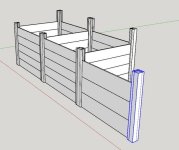Soldato
Our existing 3 bay/bin compost heap is falling apart. It was assembled from old pallets and scrap wood by the previous owner.
My plan is use to 75x75mm fence posts to build 3 new bays (so 6 posts). I'll use something like 25x38mm laths to create a vertical "grooves" on each post, then use 22x200mm boards as slats to drop in for the sides. So 25+25+22 is just shy of 75mm, so the slats should slide in with a tap but also be snug. The six corner posts will be 1.1m to 1.3m high and shielded by existing fences, so aren't that exposed to direct wind.
What I can't decide on is securing the corner posts. Options I've got so far:
My plan is use to 75x75mm fence posts to build 3 new bays (so 6 posts). I'll use something like 25x38mm laths to create a vertical "grooves" on each post, then use 22x200mm boards as slats to drop in for the sides. So 25+25+22 is just shy of 75mm, so the slats should slide in with a tap but also be snug. The six corner posts will be 1.1m to 1.3m high and shielded by existing fences, so aren't that exposed to direct wind.
What I can't decide on is securing the corner posts. Options I've got so far:
- Metal fence post spikes - in theory no digging but seem to be a loved or hated product when Googling. Cost about £7 each, so £42
- Concrete in supports - Screwfix - £39 plus concrete
- Dig holes and use Postcrete. Relatively quick but makes the inevitable job of digging out the concrete once the posts rot through a pain. Wins on price at £27 (£4.50 a bag from Wickes)
- Fence fins - http://www.fencefins.com/ - about £10 each, so around £60 for the job. Hadn't seem them before I was Googling today though.



